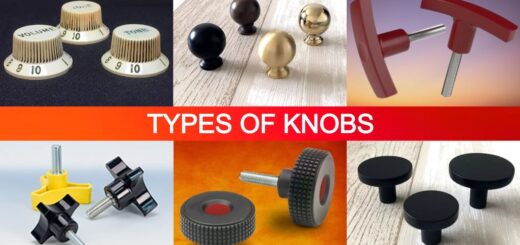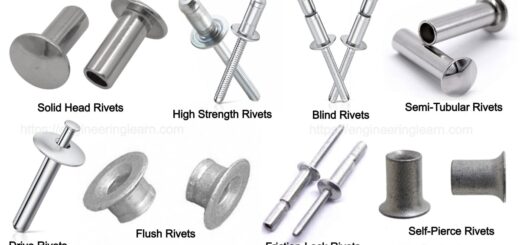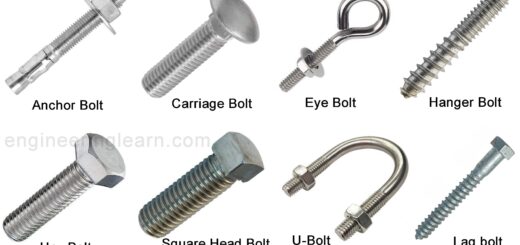7 Parts of Screw and Their Function [Complete Guide]
![7 Parts of Screw and Their Function [Complete Guide]](https://engineeringlearn.com/wp-content/uploads/2023/04/Parts-of-Screw-1024x539.jpg)
Introduction
7 Parts of Screw and Their Function [Complete Guide]: – Screws are presumably the most widely recognized stainless steel fasteners that are utilized in each industry. They are essential to all tasks and equipment. In no way related to bolts, they are utilized to secure at least two or more surfaces together. As the screw passes through the surfaces, it “digs” out material by means of its external threading. Regardless of whether you’ve utilized screws, however, you might be new to their different parts.
Screws are in many cases self-threading (otherwise called self-tapping), while the screw is turned, the threads cut into the material, making an inner thread that helps fully fastened materials together and forestalls pullout. There are many screws for different materials; Materials regularly attached with screws incorporate wood, sheet metal, and plastic.
What are Screws?
Screws are one of the world’s most common kinds of fasteners. A screw is a general category of mechanical fastener with a threaded shaft, which is designed to screw into a part or section. Screws frequently depend on friction at the threads to remain secure as well as safely secured. The fasteners which are utilized to fasten materials are known as screws for example hammers or screwdrivers.
A screw is a mix of basic machinery, it is basically an inclined plane wrapped over a central shaft, yet the inclined plane additionally goes around the outside to a sharp edge that goes about like a wedge as it is pushed into the fastened material, shaft, and helix moreover form a wedge at the tip.
Screws are many times manufactured as self-threading, and that implies the thread cuts into the material when the screw is turned. This creates an interior thread that permits the fastening material to be pulled and prevents it from being pulled out.
These are accessible in various shapes and sizes, and each has various functions. Screws are typically round, flat, short, long, and many more, yet it will be challenging to distinguish or be aware of them for your project they are accessible in different sorts. Screws give more strength and holding power than nails. Also, assuming something should be dismantled, screws can undoubtedly be removed. For most home repair purposes, wood screws will do the trick.
Parts of Screw
1. Drive: ( Parts of Screw )
These parts are otherwise called screw heads. The tip of the screwdriver which will fit to rotate or pivot the screw in a particular slot is called a drive. There are different sizes and states of drives accessible. As per that, it ought to be better to have various screwdriver tips in a personal toolbox.
2. Tip: ( Parts of Screw )
The sharp or pointed end of a screw is known as a Tip. Most screws have a sharp and pointed tip that is ready to drill a hole into surfaces. The tip is normally narrower than the remainder of the screw. This permits it to penetrate or enter in any case hard materials. Without a tip or with a wide tip a screw might battle to penetrate hard materials. The tip frequently changes relying on what material the screw is intended to be utilized on.
3. Head: ( Parts of Screw )
The head is the top segment of a screw. There are two sorts of screw heads: traditional and counter-sunk. Counter-sunk heads are intended or expected to rest flush with the surface into which they are driven. If we compare counter-sunk heads with traditional or conventional screw, conventional screws heads project away from the surface into which they are driven. Both traditional and counter-sunk screw heads feature at least one notches, which is designed to help the utilization of a screwdriver. You should press the screwdriver into these notches to drive a screw into the surface, after which you can turn the screwdriver.
4. Threading: ( Parts of Screw )
The section or part of a screw that contains helical ridges is called threading. Screws depend on this threading to eliminate material from the surfaces into which they are driven. The threading basically or fundamentally scoops out material as the screw is driven into a surface. At the point when a screw is driven into a surface, it will displace a portion of the surface’s material. The material will travel up and out of the surface once it enters the helical ridges.
5. Crest: ( Parts of Screw )
The crest of the thread is the significant part of the thread, whether it is inner or outer. The valley of the thread is called the crest.
6. Shank: ( Parts of Screw )
Screws likewise have a shank. For wood screws, the shank is the unthreaded portion or segment that is found over the threaded part. Wood screws have an unthreaded shank to create a more grounded and secure hold. With the simply aspect of a wood screw being threaded, it offers a more stronger or grounded hold than that of conventional or standard screws completely threaded from beginning to end. Different sorts of screws have a completely threaded shank, meaning the threading expands as far as possible from the head to the tip. Wood screws are different in light of the fact that they quite often have an unthreaded shank.
7. Thickness: ( Parts of Screw )
The thickness of the screw is measured or estimated as well as assessed by two diameters which is the minor and major diameter. The thickest part of the thread is called a major diameter and the distance across the base of the screw is known as minor thickness.
How Does a Screw Work?
The world of screws is immense, and you’ll find no shortage of various options when you look for screws for your next project. A screw is powered and controlled by the movement of the screwdriver. It changes over this rotational force into up and down-force. You’ll require a screwdriver or drill that is suitable with the head design to drive the screw into the material.
A screw’s power relies on how close together are the threads and the distance away from the center of the screw force is applied. By making the threads too close together, you can get more power.
There is a wide range of sorts of screws, and keeping in mind that their exact uses contrast, what a screw really does best is keep two things intact. What are various parts of screws? Below we discuss the various parts of screws accessible to you and their manufacturing process, as well as some vital information as you assess which parts of screws will work best to address your needs.
What is the Manufacturing Process of a Screw?
There are three significant stages in manufacturing a screw.
- Heading
- String rolling
- Covering
The screw is normally made using wire. Afterwards, the wire is cut to the appropriate length for the sort of screw being made. The head of the screw is produced by the heading. The die’s shape in the machine directs the features to press into the screw head, for instance, a round head screw utilizes a round die.
The threads are normally produced by means of thread rolling. Be that as it may, some are a machine. At last, a coating or covering, for example, electroplating with zinc or black oxide, is applied to forestall corrosion.
Conclusion
Notwithstanding these primary parts, a few screws may likewise have additional features relying upon the screw type and its application. The most widely recognized additional feature is a washer, standard, or locking. The washer provides a superior seal and distributes the load all the more equally across a larger surface. In the extent of wood screws and deck screws to specialty screws for machining, woodwork, or metalwork, picking the right fastener will make your task go smoothly and effectively. As discussed above, there are many sorts of screws, so purchasing the right screws for your material makes the best of your venture.
Now and again screws are characterized by the material they are utilized to fasten. For instance, you could find you want concrete screws for fastening objects to concrete, wood screws for fastening objects to wood, or drywall screws for fastening objects to drywall. No one screw or fastening might actually act as a one-size-fits-all solution, since there are basically such a large number of necessities and applications for screws and fasteners.
Image Source: – iqsdirectory













